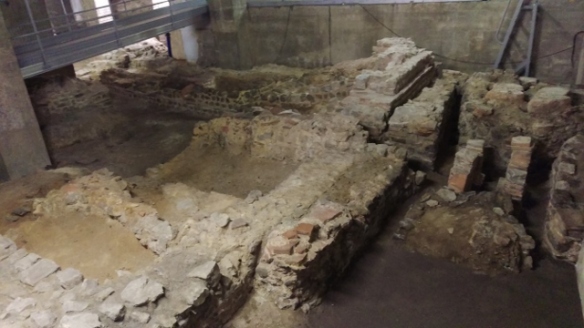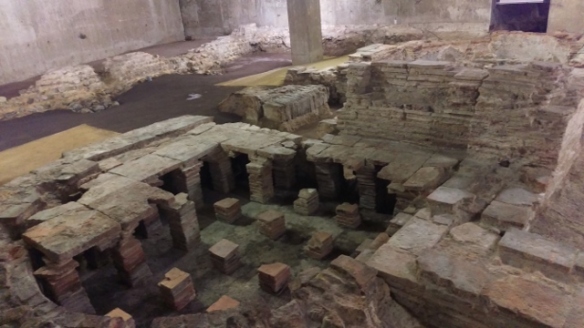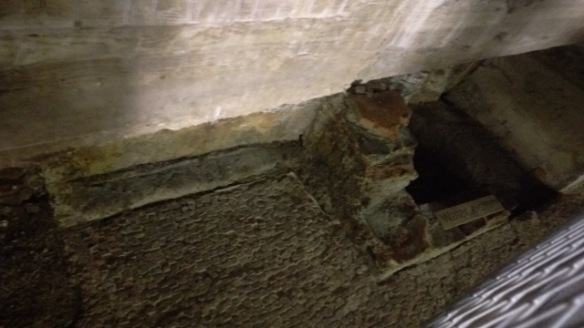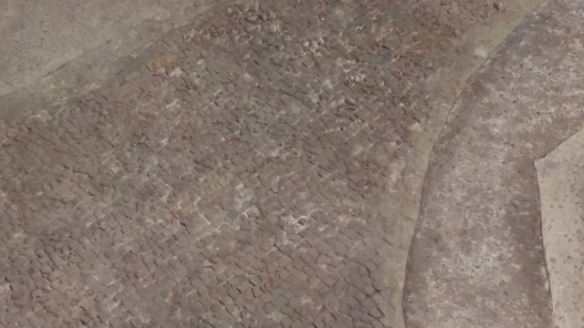The Museum of London is my favourite museum. When I first arrived in London, I spent a too-short couple of hours sheltering there from the January cold before a meeting-over-a-drink on London Wall and over the years I have visited several times, not just for new events but also to revisit the permanent exhibition. It’s the patchwork of all of London’s faces through history that I find so endlessly fascinating.
Anyway, the Museum is trialling a series of Archaeology Archive events over the next few months, opening up sites for the public to visit and to learn more about what went on here well before we were a twinkle in anybody’s eye. So at 2.45 yesterday afternoon, I entered the nondescript door at 101 Lower Thames Street and followed our Museum of London guides, Joe and Nicola, down the short flight of stairs to the Roman House and Bath.
The house and bath is thought to be from the period leading up to 400AD – the story of the site came to life under Nicola’s passionate telling: the building and its abandonment – probably around the late 4th/early 5th century when Rome withdrew its support from Londinium – the unusual layout of the bath house and why it might have been built that way, and how archaeological evidence – or absence thereof – plays its part in refining the story. There still remains some debate as to whether this was a mansio – a ‘stopping point’ – or a family home but that in no way diminished the impact of what we saw.
The tour began with a look at the east wing, what was thought to be the furnace room and the remains of the hypercaust heating system beneath the floor.

The east wing – you can see hypercaust tiles to the right. The furnace room is on the other side of the walkway and links through a series of channels under the floor to circulate warm air throughout.
We then spent some time looking at the bath. Comprised of a frigidarium cum change room in the centre, the tepidarium (warm room), caldarium (hot room) and plunge pool, Nicola’s narration took us back over 1600 years, introducing us to the family who may have lived here.

You can see the layout of the bath here. The frigidarium was the flat area in front, to the right you can see the site of the caldarium (hot room) with its hypercaust tiles and the furnace that you can see just on the outside of the wall). The family would have walked through a small connecting room to the tepidarium (warm room) on the other side (left side of picture).
They may have trodden the tessellated floor of the frigidarium to change, walked through to the tepidarium to acclimatise to the heat, then visited the caldarium for a short time before returning to the tepidarium to relax, chat and receive the cleansing ministrations of various experts (scraping the skin with a strigel was a common method of removing the dust and grime of London).

The tepidarium – you can see the remaining floor level tiles sitting above the the hypercaust pillars
And let’s not forget an invigorating dip into the plunge pool before leaving the bath.

The plunge pool was located at our backs as we looked over the frigidarium. It’s not huge – just enough for a dip in and out.
Just under an hour later, our small group headed back up the stairs and, after signing the visitors book, emerged onto the sunlit street. I still find it quite hard to believe that all of that fabulous history lies beneath an unassuming office block opposite the imposing Billingsgate Fish Market on a roadwork-strewn City street.
The Roman House and Bath is a Scheduled Monument which means that it is registered as one of Historic England’s 5627 important archaeological sites. It also means that it is a legal requirement of the owners/occupiers of the property to protect the site. The Museum of London plays a big part in this with teams of historians, archaeologists and conservators overseeing preservation efforts.
This trial – the opening of their Archaeological Archives – is an effort to raise public consciousness about London’s history and encourage visitation albeit, with a small fee, in the hope that there will be support and funding for a permanent programme.
If you are fascinated by history and/or London and have an hour one weekend to visit the Roman House and Bath – or any of the other openings in this year’s trial – please do it. Being able to stand beneath the street, to see this and listen to the expertise and passion of people like Nicola and Joe from the Museum of London is an absolute privilege.
It would be a shame if the doors were closed again and the conservators were left to appreciate London’s past alone.
———————————————————–
For more information about this special programme, visit; http://www.museumoflondon.org.uk/london-wall/whats-on/adult-events/archaeology-events/


Pingback: The wall | Gidday from the UK
Pingback: The window | Gidday from the UK
Wish I could head right over (you know, because I’m a giver)! Will have to hope the trial works and these sites will be available to appreciate when I’m able to visit one day.
LikeLiked by 1 person
My fingers are crossed for you Amy!
LikeLiked by 1 person